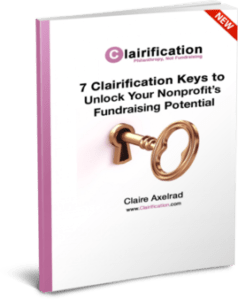
Take calculated risks when you’re ready
As you plan for the year ahead, it’s smart to think about risk vs. reward.
Sometimes you feel like a risk; sometimes you don’t.
If everything is going along swimmingly, and you want to take things to the next level, then taking a calculated risk may be just the thing.
If you’re not yet maximizing return using tried-and-true best practices, then going the risky route may make less sense.
If you’re wondering when to take risks with your nonprofit’s marketing and fundraising, here’s my answer: When you’re ready.
Begin by determining which current strategies are your most rewarding. Do you have good basics in place?
You Can’t Riff Without a Guitar

Learn the basics in order to riff successfully.
News flash: You’ve got to do the basics before you improvise.
Too many nonprofits lose sight of the basics upon which all successful marketing and fundraising is premised. I talk about this in my 7 Clairification Keys to Unlock Your Nonprofit’s Fundraising Potential. The basic pre-conditions to success break down into first clarifying your: (1) Values; (2) Stories; (3) Brand; (4) Social Channels; (5) Support Constituencies; (6) Engagement Objectives and (7) Resources/Systems. It’s best practice to have clarity and consensus in all these essential areas.
Imagine you want to play guitar like a jazz virtuoso, whiling away the day jamming with some friends. But… you’ve never played a single note. And you don’t own a guitar. Clearly, you need an instrument and instruction. You’re not ready to riff just yet. Not until you’ve learned the basics.
Nonprofit marketing and fundraising work the same way. Sure, you can ignore the art and science that’s come before. But it’s not very smart. In order to ignore something with intention, you’ve got to learn it first. Otherwise, you’re going to waste a lot of time and resources.
TRUE STORY: I transitioned into fundraising from a brief career in law. Before accepting my first position in nonprofit development, some wise mentors counseled me to take a week-long Fundraising 101 course at the Fundraising School (now part of the Lilly School of Philanthropy). It was the best thing I could have done! I came away thinking: There’s already a sound body of theory and practice here; I could make this a career! There’s a right and wrong way to do things; I don’t have to fly by the seat of my pants!
Time and again, nonprofit leaders come to me asking for help with a new campaign or social media strategy. They want to riff (which means variation on a theme), yet they don’t have the theme nailed. They lack clarity and consensus around fundamentals. They don’t have best practices in place.
Best Practices Get a Bad Rep

Practice makes perfect!
News flash: Don’t ignore the past; learn from it.
People who want to dismiss arguments with which they disagree tend to pooh-pooh best practices. They play down, or express contempt for, things they may not even understand. And in this manner they excuse themselves from putting the basic keys to success in place.
Classical music is boring.
We don’t need old-style direct mail.
Traditional chord work is tedious.
Major individual gifts aren’t for us.
Too much practice makes you stale.
We don’t need a formal donor retention program.
You can make excuses too, but I wouldn’t recommend it. Opinion above knowledge is just about the riskiest thing you can do. Because no matter what you think, much of what has always worked still works. For example:
- PROSPECTING: Direct mail is still the best medium for cutting through the clutter and getting your marketing message directly in the hands of your customers. There’s plenty of documented science, art and best practices to help you know which strategies perform best.
- ASKING: Major individual gifts account for the lion’s share of philanthropy, with 88% of dollars raised coming from 12% of donors. The number one reason people don’t give is simple: they aren’t asked. There’s no way around this. You’ve got to stop cultivating at some point and make the ask. Cultivation is a means to an end; not the end in and of itself. There’s also plenty of documented art and science
- STEWARDING: A 10% increase in donor retention can increase the lifetime value of your current donor base by 200%. On average, nonprofits retain just 46% of all donors and only 23% of first-time donors [Fundraising Effectiveness Project].
There are plenty of other best practices that also work like gangbusters – when conceived and implemented well. That’s the point. To be successful, you need to create a playlist, learn the melodies and master the lyrics.
What’s on your playlist for the coming year? The rewarding gold standards like prospecting, asking and stewarding? Or riskier new events? Special campaigns? Add-on social media?
You’re to be congratulated if you’ve got innovative ideas. It shows you haven’t lost your creative spark, and you’ve got gusto and passion for what you do. Bravo! But… wait… hold on a minute…
You Can’t Put the Cart Before the Horse

This doesn’t seem that rewarding.
News flash: You can’t leverage success until you’ve achieved success.
While it’s definitely true that success today requires exploring new strategies (direct mail and digital work together, for example: (1) 80 – 90% of donors will visit your website before giving; (2) ) a large percentage of donors prefer to respond to direct mail by giving online, and (3) direct mail donors are 50% more likely to respond if they receive multi-channel messages that reinforce the call-to-action), you can’t put the cart before the horse.
- Your website is more important than social media, because the latter drives folks to the former. If when folks arrive at your website they can’t find what they’re looking for, or it’s too difficult to take an action, then you’ve missed the point of the whole endeavor.
- Your donation landing page is of equal importance to your mailed reply device. Because many folks will give online, regardless of where they saw your appeal. And your landing page design and copy is not compelling and easy to grasp within the first 2 – 8 seconds, they won’t complete the gift.
- Your mailing list is more important than the content of your appeal. Even the most brilliantly crafted appeal won’t raise much money if sent to the wrong people. Or not enough people.
- Your thank you letter is of equal importance to your fundraising letter. Because if you don’t thank well, you won’t get a second gift.
You Can’t Build a House Without a Foundation

Have you laid your fundraising foundation?
News flash: You’re not ready to raise the roof unless you’ve got the pre-conditions nailed down.
Your house may stay upright for a little while, but ultimately it will come crashing down. So think about your own development plan. What’s missing from the foundation? What pre-conditions to success are not in place? Here are some usual suspects:
- Fuzzy case for support. It may be too broad, and thus not appeal to specific donor passions. The key is to be able to break it down so donors can easily visualize how their gift will be used.
- Board unwilling to fundraise. If your leaders don’t walk the talk, why should anyone else?
- Lack of adequate staff and/or infrastructure. You’ve got to spend money to make money. It takes hard work, not magic. It takes modern tools, not simply what my former boss used to call “loving hands at home.” It’s very difficult to manage smart donor acquisition, solicitation and retention from an Excel spreadsheet rather than a database.
- Unclear branding. This often stems from silos, where different departments send out different messaging, leading to a confused perception of what you stand for.
Sometimes Moving Forward is Just Going Back to Basics

Learn what you need to succeed
Don’t get me wrong; I’m not telling you to avoid risks.
We live in an astoundingly fast-paced world, where things change daily. The digital revolution irrevocably disrupted “business as usual” and those who fail to adapt will die. As Reid Hoffman, co-founder of LinkedIn, noted: “Ironically, in a changing world, playing it safe is one of the riskiest things you can do.”
So, once you’ve got the guitar and are strumming along nicely… once you’ve laid the foundation and are ready to build up… you don’t have to always play it safe. In fact, you shouldn’t. There’s a definite risk in standing still. But there’s a world of difference between nailing the basics and standing still.
Because a lot of where nonprofits sit on their hands is when it comes to stuff they’re afraid to do. Like asking. So you spend your time dreaming up new cultivation activities so you don’t have to ask. Events, events and more events. House parties. Tours. Coffees. On and on and on. And these are all good things, but… not in lieu of the basics.
Begin with the guitar. Begin with the foundation.
Here’s what the inimitable Seth Godin has to say about best practices:
If you need an appendectomy, it’s unlikely you’ll die during the operation.
That’s because the surgeon has been trained in hundreds of years of best practices. From Semmelweis to the latest in antibiotics, she knows what’s come before.
Not only that, but the scalpel she uses is the result of 1,000 iterations over the centuries. Every device has been sanitized based on trial and error from the millions of patients who came before you.
Surgery is an engineering project, and it’s based on best practices. Learn from the past, don’t ignore it.
Art, on the other hand, is something we value because it leaps. Art is more than engineering–art is the thing that might not work.
But even art is based on best practices. Just not as much.
The playwright better have read Bellow and Beckett. The conceptual artist should be familiar with Duchamp. The photographer and designer needs to know Debbie Millman, Robert Mapplethorpe and Jill Greenberg…
Ignore it if you want to, but learn it first.
Get the 7 Clairification Keys

Get fresh insights into how fundraising and marketing have changed, and what this means for you.
Unlock your nonprofit’s fundraising potential through a series of “clairifying” worksheets and exercises. (1) Values. (2) Stories. (3) Brand. (4) Social Channels. (5) Support Constituencies. (6) Engagement Objectives. (7) Resources and Systems. Master the basics, and learn to go above and beyond.
Grab your e-Guide here! All Clairification products come with a 30-day, no-questions-asked refund policy.





